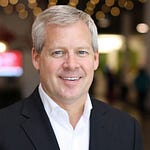This article is part of Fintech Leaders, a newsletter with 80,000+ builders, entrepreneurs, investors, regulators, and students of financial services. I invite you to share and sign up. If you enjoy this conversation, please consider leaving a review on Apple, Spotify, or Youtube.
I sat down in NYC with Anré Williams, Senior Executive Advisor at American Express. He has spent over 35 years at Amex, rising from summer intern to, most recently, CEO of American Express National Bank, which represents 60% of the company's revenues. Under his leadership, Amex transformed its banking business into a top 25 US bank by assets.
Amex is one of the oldest financial services companies in the world. The company is 150 years old and in 2024, they reported record revenues of $66 billion dollars.
Q&A With Anré
The following is a summarized transcript of my conversation with Anré.
Miguel Armaza: Tell us about your journey at American Express. You've spent the last 35 years there, rising from an intern to leading one of its most important divisions.
Anré Williams: It was 36 years ago when I first interacted with American Express as a summer intern. I spent 35 years working there full time, and I'm still there now, although it was announced I'm leaving in November 2025. It's been a great ride with a wonderful company.
The company itself is 175 years old and has really transitioned through different eras - starting as a transportation company in freight forwarding, then moving to travel and lifestyle focus, becoming a financial services supermarket, and now for the last 20 years or so, really honing in on payments, which it has done very well.
What's kept me engaged is that I've had 15 different roles during my tenure. I started in marketing, worked with college students, high-net-worth Platinum Card members, the small business group, corporate clients, merchant acceptance, bank partnerships, technology - a lot of different roles that kept me interested throughout my career.
Leading American Express National Bank
Miguel: Let's talk about your most recent role as CEO of American Express National Bank, which represents about 60% of company revenues. How is this bank different from traditional banks?
Anré: American Express National Bank is now a top 25 bank by assets in the United States, but many people may not be familiar with it because we don't have branches, don't run commercials, and don't do billboards. Most of the bank's customers are card members.
American Express has always had a banking license to fund some of its activities, but it really expanded during the global financial crisis. When banks were disappearing or being acquired, and there was concern about access to capital, we created high-yield savings accounts and certificates of deposit. Customers felt comfortable giving us their money because American Express had been around for over 150 years, with a brand built on trust, security, and service.
That became a source of capital for our business, growing every year to where we now have over $100 billion in high-end savings accounts, mostly from current customers but not exclusively. So it's a digital bank with no branches - not widely known but very important in the US banking system.
Navigating Three Major Crises
Miguel: You've navigated three major crises during your career - 9/11, the global financial crisis, and COVID. What was happening inside the company during these times, and why did Amex emerge stronger?
Anré: We learn a lot through history. For 9/11, our world headquarters was across from the World Trade Center. We had to immediately evacuate, and no one worked in that building for 11 months. The country was in recession, all airports closed for days, and we were the largest travel agency in the world. Our stock price dropped dramatically, but we made it through and thrived.
The global financial crisis was another tough period, with many New York-headquartered banks going out of business or being purchased.
When the pandemic started, we relied on a recession readiness playbook we had developed. We committed to no layoffs in 2020, even for employees who couldn't come to the office. We focused on maintaining strong customer relationships through the difficult period. We also thought about what we could modify in our business model to emerge stronger.
During COVID, we developed the financial relief program. We told customers who couldn't pay their bills in full that if they committed to paying a portion monthly for an agreed period, we would maintain their accounts without reporting delinquencies to credit agencies. Once they paid their balance in full, we'd fully restore their card spending privileges. This approach was very different from other financial institutions that were aggressively cutting credit lines and cards. Not every participant paid in full, but a majority did, and they became very loyal to the company.
Amex’s Secret to Low Loss Rates
Miguel: It's a good time to talk about Amex's famously low loss rates. Is this due to your customer segments or your risk management approaches?
Anré: It's not just one thing. Yes, we serve customer segments - both small business owners and consumers - who have track records of spending and paying their bills well over time. That's helpful in selecting who to approve, and these people tend to gravitate toward our products and are willing to pay fees.
Our business model is unique in that we have information at both the card member level and the merchant level. We see information flowing on both sides - where you make a transaction, what day, what time, what location - all factors in your likelihood to repay. It helps us detect fraud patterns too.
Then there are many talented colleagues with unique skills and modeling capabilities who devise ways to manage risk effectively. So it's really a combination of all three elements working together.
Global Merchant Expansion Strategy
Miguel: I think those of us who travel often remember a time when American Express wasn't widely accepted in smaller markets. That's changed dramatically. You led global merchant expansion - what was your strategy?
Anré: For about 10 years, I was responsible for all the places that accept American Express worldwide. Expanding acceptance was one of the most important things we could do, so card members would feel comfortable using their cards while traveling.
We use different models globally. In the United States, our employees drive acceptance. In Brazil, we have an outsourced model with partner banks issuing cards, providing customer service, and signing up merchants. In the Middle East, we have a joint venture with a Saudi Arabia-based entity.
We made two pivotal changes that made a big difference. First, we decided to work aggressively through partners - payment facilitators and aggregators like Stripe and Square that sign up merchants to accept all credit cards. We wanted American Express to be part of that bundle.
Second, we focused intensely on locations that matter to current customers. We aggregated data from all our card members globally to identify where people attempt transactions. We ensured coverage in those places and focused on industries beyond what people might associate with American Express - not just airports but public transit, and not just restaurants but food trucks, coffee shops, stands, and vending machines. These strategic shifts greatly expanded our acceptance.
We weren't tracking individuals - we were aggregating data from thousands or millions of customers with similar profiles to identify the 50-60 locations they were likely to visit, then blanketing those places with acceptance.
The Origin Story of American Express
Miguel: American Express is 175 years old. How did the company get started?
Anré: It was a freight forwarding company founded in 1850 by three gentlemen, including Henry Wells and James Fargo. They forwarded freight between cities like New York to Boston or Philadelphia, and sometimes all the way to San Francisco. They also protected customers' goods - if items didn't arrive, American Express would pay to replace them.
What's interesting is that this had nothing to do with payments or cards. The first American Express card didn't exist until 1958, when the company was already over 100 years old. Throughout all these transitions, the consistency of trust, security, and service has always been hallmarks of the company's brand.
It's fascinating that many of today's largest financial institutions started in the 1800s by helping create trust in the trading business - imports and exports, whether within the same country or internationally.
The Gen AI Council at Amex
Miguel: What is the Gen AI Council at American Express?
Anré: About two and a half years ago, when generative AI became more broadly discussed, American Express wanted to participate. We saw potential to leverage large language models to provide better customer service and improve our products and capabilities.
Before implementing anything, we recognized the industry-wide concerns about hallucinations, data security, privacy, and many other issues. So we formed a council with representatives from our privacy team, legal team, model governance, and technology - a cross-functional group of senior leaders to ensure any moves we made in generative AI would protect our customers' long-term interests.
The council ensures we're checking all the right boxes to protect customer information, maintain data privacy, and implement model governance that regulators would approve. We have to be very thoughtful about everything we do.
We've found applications in our technology organization, where coding assistants help software engineers be 10-12% more productive by their own reporting. Our customer care professionals can access information more quickly to answer questions when card members call or chat. We had over 500 use cases under consideration, testing them to see what works before scaling the successful ones.
Partnering with Fintech Startups
Miguel: American Express has many partnerships. Fintech is often about partnering. How do you think about partnerships between fintechs and established institutions?
Anré: I think it's critically important for large institutions to both partner with and respect fintechs and startups. Innovation often comes from smaller companies. It's not that larger banks or institutions can't innovate, but sometimes it's more difficult because of regulatory environments and constraints about how quickly they can move.
I recall when Square created that small dongle you could plug into your phone to enable credit card transactions. That was really innovative. American Express could have potentially done something similar since we had merchant terminals, but for whatever reason, we didn't pursue it. Square focused intensely on enabling cash-based transactions to move to card payments.
We partnered closely with Square early on because they were signing up merchants we might never have reached and creating new merchants from people who previously only accepted cash. This expanded payments in the United States and other countries, aligning with our goals.
For founders selling to banks or large financial institutions, I advise focusing first on your customer segment and where you have differentiated value. Don't worry initially about who might buy your business or partner with you. Focus on providing superior service to customers. Second, recognize that larger institutions have different constraints, so determine whether you can comply with those constraints while still achieving growth through partnership.
Ken Chenault's Leadership
Miguel: Ken Chenault, former CEO of American Express, has become important in the fintech and VC industry. Can you tell us about working with him?
Anré: I've known Ken my entire career. When I started as a summer intern, he was just a division president, not the iconic CEO. Our relationship evolved from him being someone I looked up to, to heading my division, to becoming CEO, to being my direct boss for several years. Now I see him as one of many impactful mentors I've had.
Ken has always maintained a long-term point of view. He's consistently thoughtful and kind in his interactions, whether supporting someone embarking on a new venture or terminating someone from the company.
He was visionary in looking to partner with fintechs 15 years ago, saying "American Express is a big company, but we can learn from these small companies." He would visit Silicon Valley and spend time with founders. I had the opportunity to accompany him on some early trips, meeting founders who went on to build major companies like Airbnb. Ken formed relationships with these entrepreneurs before many others recognized their potential.
Favorite Amex Rewards Experience
Miguel: Do you have a favorite American Express rewards experience?
Anré: I have Membership Rewards points, and like all card members, I can go online, look at my statement, and select charges to pay for with points. Occasionally, I'll treat myself - maybe I bought a pair of shoes or a sweater, and I'll pay for it with points.
But what I think is truly one of the best uses is when business owners with small or mid-sized accounts accumulate significant points from their purchases and use them to thank and reward their employees. I love hearing a business owner say, "We had a holiday party, and I cashed in some points for gift cards and presents for my employees." That's really nice.
On Mentorship
Miguel: You're known for developing talent within American Express. What's your definition of a good mentor?
Anré: A good mentorship relationship goes both ways. People often think, "If this person mentors me, here's what I can get," but I always ask, "What does the mentor get from spending consistent time with you?" Mentees should consider how they might help their mentors. It's a mutually beneficial relationship - maybe 80/20, not 100/0.
Also, we often think of mentors as more senior people with more experience, but that's not always the case. One of the most impactful people in my career was an executive assistant. She didn't have direct reports but had been with the company for years and worked with senior leaders. One day she pulled me aside and said, "Young man, you seem to be working really hard. Here's something you should watch out for." She gave me invaluable advice. Over the years, I've gone back to her for perspective, and she's always provided wise counsel. No one would think this person would be someone I'd consider a mentor.
Want more podcast episodes? Join me and follow Fintech Leaders today on Apple, Spotify, or your favorite podcast app for weekly conversations with today’s global leaders that will dominate the 21st century in fintech, business, and beyond.
Previous Episodes You May Enjoy:


























Share this post